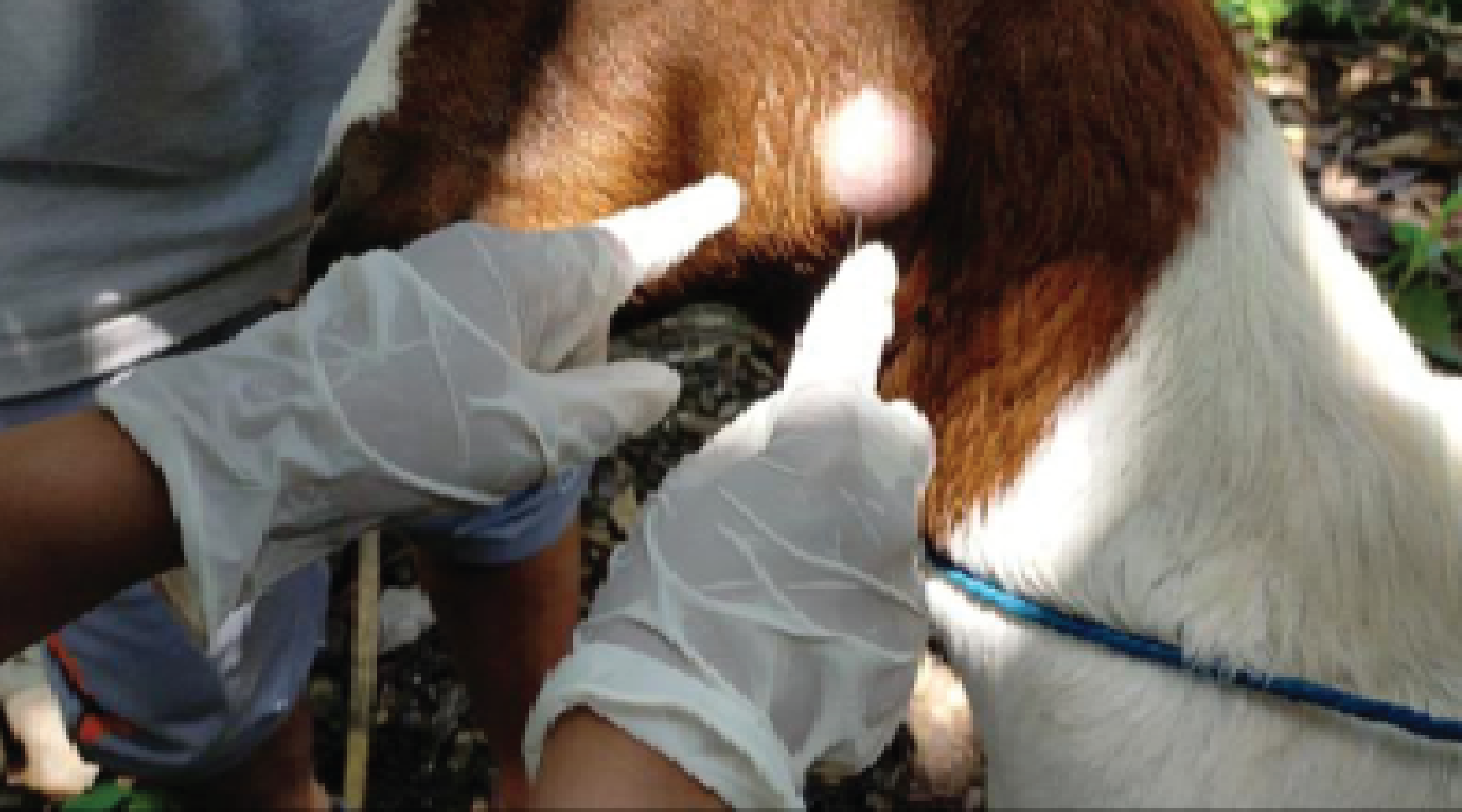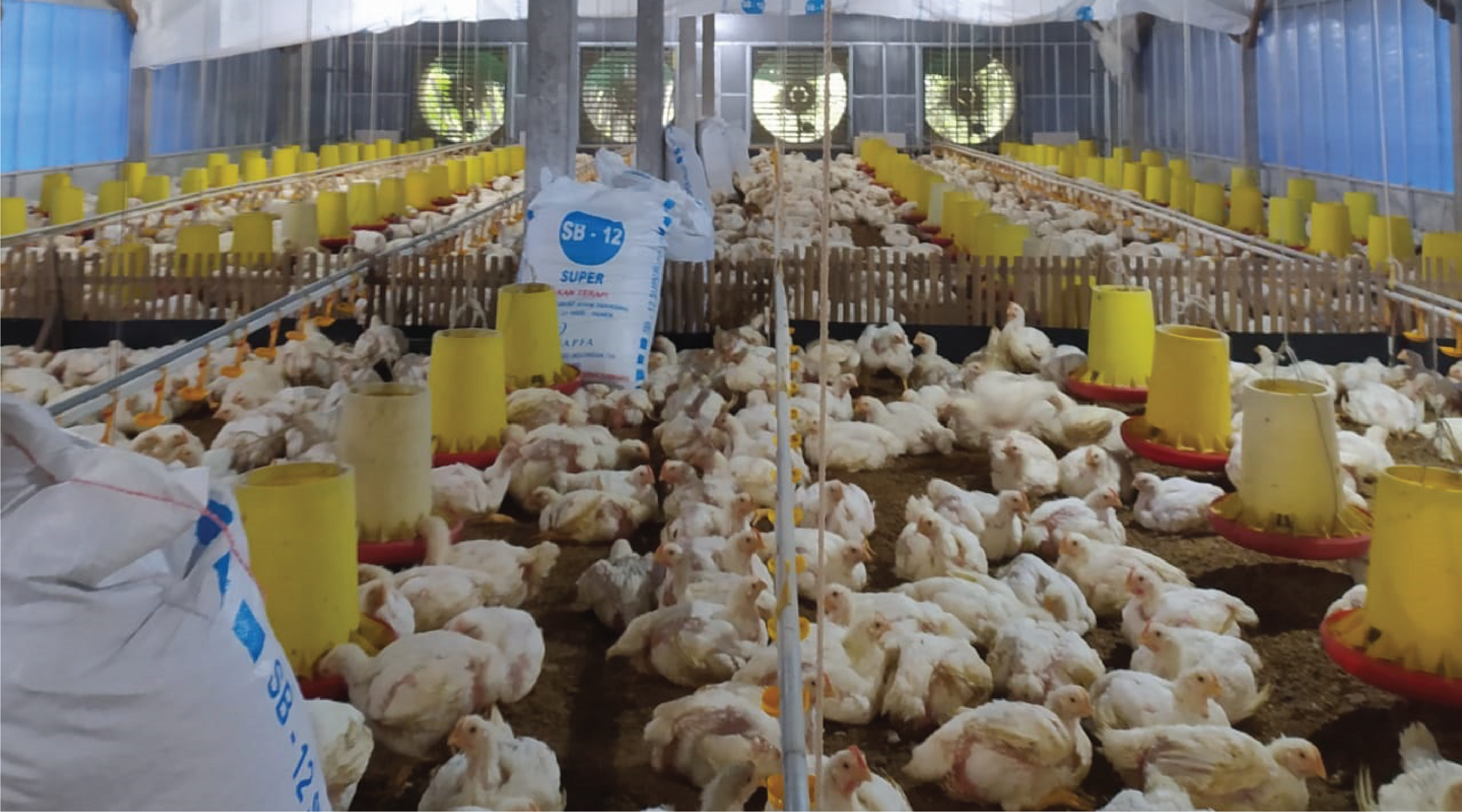A Study on the Ectoparasites and Hemoparasites Infections in Rodents from the Kilwa district, Tanzania

Downloads
Background: Ectoparasites play a significant role in facilitating the transmission of disease pathogens and parasites that affect animals and humans. Purpose: This study aims to assess the prevalence of ectoparasites and hemoparasites in rodents from the Kilwa district, Tanzania. Method: A cross-sectional study was conducted to trap 138 rodents using Sherman and wire cage traps. Ectoparasites were removed from rodents by using fine brushes and identified based on morphological features using a Stereo microscope with the assistance of dichotomous taxonomic keys. Blood samples were collected from supraorbital veins in captured rodents, and thick and thin smears were made, stained and examined using a Compound Microscope for screening hemoparasite. Results: The overall prevalence of ectoparasites in rodents was 57.87 % with a high infestation of rodents by Echinolaelaps (Laelaps) echidninus (44.20%) than Laelaps nuttalli (10.87%), Xenopsylla cheopis (12.32%), and Rhipicephalus appendiculatus (2.90%). Most ectoparasites were found in M. natalensis 76.40% followed by R. rattus 25.81%, and G. leucogaster 36.36%. Adult rodents recorded 63.41% of ectoparasites prevalence higher than juveniles 13.33% (p< 0.05). The overall prevalence of hemoparasites in rodents was 18.12%. The identified hemoparasites were Anaplasma sp. (13.04%), Babesia sp. (3.62%), and Trypanosoma sp. (1.45%) observed only in adult rodents. Conclusion: The study recommends engaging and encouraging the community to use integrated pest management practices for rodents and ectoparasite control and prevention to safeguard both human and animal health.
Abdullah, D., Ali, M., Omer, S., Fadunsin, S., Ali, F., and Gimba, F., 2019. Prevalence and Climatic Influence on Hemoparasites of Cattle and Sheep in Mosul, Iraq. Journal of Advanced Veterinary and Animal Research, 6(4), 492-498.
Alemu, S., and Kemal, J., 2015. The Properties of Selected Medicinal Plants Against Bovicola ovis and Amblyomma variegatum: A Review. European Journal of Applied Sciences, 7(6), 277–290.
Baak-Baak, C.M., Cigarroa-Toledo, N., Torres-Chablé, O.M., Arana-Guardía, R., Puerto, F.I., Machain-Williams, C., and García-Rejón, J.E., 2016. New Records of Ectoparasites Echinolaelaps echidninus and Polyplax spinulosa on Rodents with Serological Evidence of Flavivirus Infections at Mérida, Yucatán, México. Southwestern Entomologist, 41(1), 75–85.
Bakre, A., Omotosho, O., Adelakun, O., and Alaba, B., 2020. Prevalence of Haemoparasites in Cattle Slaughtered at Central Abattoir in Igboora, Oyo State, Nigeria. International Journal of Livestock Research, 10(10), 74-79.
Campbell, J. D., Bennett, S., Krueger, L., Morgan, T., Nguyen, K., Penicks, A., Sun, S., Cummings, R., Martinez, D., and Quinn, N., 2018. Flea‘in Around: A Look at the Identification, Preservation, Clearing, and Mounting of Siphonaptera. In: Proceedings of the Vertebrate Pest Conference, 28(28), 163–172.
Dada, E.O., 2016. Study on the Ectoparasites and Haemoparasites of Domestic Rats in Parts of Akure South Local Government Area of Ondo State. International Journal of Clinical Chemistry and Laboratory Medicine, 2(1), 1–5.
Dahmana, H., Granjon, L., Diagne, C., Davoust, B., Fenollar, F., and Mediannikov, O., 2020. Rodents as Hosts of Pathogens and Related Zoonotic Disease Risk. Pathogens, 9(3), 202.
Dehghani, R., Vazirianzadeh, B., Asadi, M. A., Akbari, H., and Moravvej, A., 2012. Infestation of Rodents (Rodentia: Muridae) Among Houses in Kashan, Central Iran. Pakistan Journal of Zoology, 44(6), 1721–1726.
Deng, A.A., Lita, E.P., Ochi, E.B., Nzalawahe, J., and Katakweba, A.A.S., 2024. Prevalence of Ectoparasites and Hemoparasites in Rodents and Shrews in Ilemela District, Mwanza Region, Tanzania. Journal of Applied Veterinary Science and Technology, 5(1), 72–77.
Ellis, J.T., Morrison, D.A., and Reichel, M.P., 2003. Genomics and Its Impact on Parasitology and the Potential for Development of New Parasite Control Methods. DNA and Cell Biology, 22(6), 395–403.
Garshong, A., Attuquayefio, K., Holbech, H., and Adomako, K., 2013. Distribution and Abundance of Small Mammals in Different Habitat Types in the Owabi Wildlife Sanctuary, Ghana. Journal of Ecology and The Natural Environment, 5(5), 83–87.
Gebrezgiher, G.B., Makundi, R.H., Katakweba, A.A.S., Belmain, S.R., Lyimo, C.M. and Meheretu, Y., 2023. Arthropod Ectoparasites of Two Rodent Species Occurring in Varied Elevations on Tanzania’s Second Highest Mountain. Biology, 12(3), 394.
Gomes Rodrigues, H., Hautier, L., and Evans, A.R., 2017. Convergent Traits in Mammals Associated with Divergent Behaviors: The Case of the Continuous Dental Replacement in Rock-Wallabies and African Mole-Rats. Journal of Mammalian Evolution, 24(3), 261–274.
Hamidi, K., Nourani, L., and Moravvej, G., 2015. The Relationship of Ectoparasite Prevalence to The Capturing Season, Locality and Species of The Murin Rodent Hosts in Iran. Persian Journal of Acarology, 4(4), 409-423
Happold, D., and Lock, J.M., 2013. The Biotic Zones of Africa. Mammals of Africa, 1, 57–74.
Islam, S., Rahman, M. K., Ferdous, J., Rahman, M., Akter, S., Faraque, M. O., Chowdhury, M. N. U., Hossain, M. A., Hassan, M. M., Islam, A., and Islam, A., 2020. Hemoprotozoa and Anaplasma spp. In rodents and shrews of Bangladesh. Tropical Biomedicine, 37(4), 842–851.
Issae, A., Chengula, A., Kicheleri, R., Kasanga, C., and Katakweba, A., 2023. Knowledge, Attitude, and Preventive Practices Toward Rodent-Borne Diseases in Ngorongoro District, Tanzania. Journal of Public Health in Africa, 14(6), 2385.
Kamani, J., Sannusi, A., Egwu, O., Dogo, G., Tanko, T., Kemza, S., Tafarki, A., and Gbise, D., 2010. Prevalence and Significance of Haemoparasitic Infections of Cattle in North- Central, Nigeria. Veterinary World, 3(9), 445.
Kassian, E.N., Simuunza, M.C., Silayo, R.S., Moonga, L., Ndebe, J., Sugimoto, C., and Namangala, B., 2017. Prevalence and Risk Factors of Bovine Trypanosomosis in Kilwa district, Lindi Region of Southern Tanzania. Veterinary Parasitology: Regional Studies and Reports, 9, 1-5.
Katakweba, A.A.S., 2018. The Prevalence of Haemoparasites in Rodents and Shrews Trapped from Domestic and Peridomestic Houses in Morogoro Municipality, Tanzania. A Hidden Public Health Threat. Tanzania Veterinary Journal, 36, 75–82.
Katakweba, A.A.S., Mulungu, L.S., Eiseb, S.J., Mahlaba, T.A., Makundi, R.H., Massawe, A.W., Borremans, B., and Belmain, S.R., 2012. Prevalence of Haemoparasites, Leptospires And Coccobacilli With Potential for Human Infection in The Blood Of Rodents and Shrews From Selected Localities in Tanzania, Namibia and Swaziland. African Zoology, 47(1), 119–127.
Król, N., Obiegala, A., Imholt, C., Arz, C., Schmidt, E., Jeske, K., Ulrich, R.G., Rentería‑Solís, Z., Jacob, J., and Pfeffer, M., 2022. Diversity of Borrelia burgdorferi Sensu Lato in Ticks and Small Mammals from Different Habitats. Parasites and Vectors, 15(1), 195.
Lareschi, M., and Krasnov, B.R., 2010. Determinants of Ectoparasite Assemblage Structure on Rodent Hosts from South American Marshlands: The Effect of Host Species, Locality and Season. Medical and Veterinary Entomology, 24(3), 284-292.
Lokina, R., Tibanywana, J., and Ndanshau, M., 2020. Environmental Implication of Sesame Production in Tanzania: A Case Study of Kilwa District, Lindi Region. Tanzanian Economic Review, 10(1), 73–90.
Lun, X., Wang, Y., Zhao, N., Yue, Y., Meng, F., Liu, Q., Song, X., Liang, Y., and Lu, L., 2024. Metabolism and Immune Responses of Striped Hamsters to Ectoparasite Challenges: Insights From Transcriptomic Analysis. Frontiers in Immunology, 15, 1516382.
Massawe, A.W., Rwamugira, W., Leirs, H., Makundi, R.H., and Mulungu, L. S., 2007. Do Farming Practices Influence Population Dynamics Of Rodents? A Case Study of the Multimammate Field Rats, Mastomys natalensis, in Tanzania. African Journal of Ecology, 45(3), 293–301.
Mathison, B.A., and Pritt, B.S., 2014. Laboratory Identification of Arthropod Ectoparasites. Clinical Microbiology Reviews, 27(1), 48–67.
Matthee, S., McGEOCH, M.A., and Krasnov, B.R., 2010. Parasite-specific Variation and The Extent Of Male-Biased Parasitism; An Example With a South African Rodent and Ectoparasitic Arthropods. Parasitology, 137(4), 651–660.
Mawanda, P., Rwego, I., J Kisakye, J., and Sheil, D., 2020. Rodents As Potential Hosts and Reservoirs of Parasites Along The Edge of a Central African Forest: Bwindi Impenetrable National Park, South Western Uganda. African Health Sciences, 20(3), 1168–1178.
Mayamba, A., Byamungu, R. M., Broecke, B. V., Leirs, H., Hieronimo, P., Nakiyemba, A., Isabirye, M., Kifumba, D., Kimaro, D. N., Mdangi, M. E., and Mulungu, L. S., 2020. Factors Influencing The Distribution and Abundance of Small Rodent Pest Species In Agricultural Landscapes in Eastern Uganda. Journal of Vertebrate Biology, 69(2).
Mhamphi, G.G., Msoffe, V.T., Lyimo, C. M., Katakweba, A. S., Massawe, A.W., Komba, E.V.G., and Mnyone, L.L., 2024. Detection and Characterization of Zoonotic Bartonella spp. In Rodents and Shrews Ectoparasites from Kigoma and Morogoro Regions, Tanzania. Mammalia, 88(1), 41–51.
Morick, D., Baneth, G., Avidor, B., Kosoy, M.Y., Mumcuoglu, K.Y., Mintz, D., Eyal, O., Goethe, R., Mietze, A., Shpigel, N., and Harrus, S., 2009. Detection of Bartonella spp. In Wild Rodents in Israel Using HRM real-time PCR. Veterinary Microbiology, 139(3–4), 293–297.
Mulungu, L.S., Makundi, R.H., Massawe, A.W., Machang’u, R.S., and Mbije, N.E., 2008. Diversity and Distribution of Rodent and Shrew Species Associated With Variations in Altitude on Mount Kilimanjaro, Tanzania. Mammalia, 72(3),178-185.
Mulungu, L.S., Ngowo, V., Mdangi, M., Katakweba, A.S., Tesha, P., Mrosso, F.P., Mchomvu, M., Sheyo, P.M., and Kilonzo, B.S., 2013. Population Dynamics and Breeding Patterns of Multimammate Mouse, Mastomys natalensis (Smith 1834), in Irrigated Rice Felds in Eastern Tanzania. Pest Management Science, 69(3), 371–377.
Mwamengele, G., Sabuni, C., and Mathew, C., 2024. Seroprevalence and Risk Factors for Brucellosis in Cattle and Rodents in Kilosa District, Morogoro, Tanzania. Journal of Ideas in Health, 7(4), 1123–1130.
Obiegala, A., Arnold, L., Pfeffer, M., Kiefer, M., Kiefer, D., Sauter-Louis, C., and Silaghi, C., 2021. Host–Parasite Interactions of Rodent Hosts and Ectoparasite Communities From Different Habitats in Germany. Parasites and Vectors, 14(1), 112.
Opara, M.N., Santali, A., Mohammed, B.R., and Jegede, O.C., 2016. Prevalence of Haemoparasites of Small Ruminants in Lafia Nassarawa State: A Guinea Savannah Zone of Nigeria. Journal of Veterinary Advances, 6(6), 1251.
Paoletta, M.S., Arias, L.L., De La Fourniere, S., Guillemi, E.C., Luciani, C., Sarmiento, N.F., Mosqueda, J., Farber, M.D. and Wilkowsky, S.E., 2018. Epidemiology of Babesia, Anaplasma and Trypanosoma Species Using A New Expanded Reverse Line Blot Hybridization Assay. Ticks and Tick-Borne Diseases, 9(2), 155-163.
Rar, V., Yakimenko, V., Makenov, M., Tikunov, A., Epikhina, T., Tancev, A., Bobrova, O., and Tikunova, N., 2016. High prevalence of Babesia microti ‘Munich’ type in Small Mammals From An Ixodes persulcatus/Ixodes trianguliceps Sympatric Area in the Omsk region, Russia. Parasitology Research, 115(9), 3619–3629.
Sabuni, C., Aghová, T., Bryjová, A., Šumbera, R., and Bryja, J., 2018. Biogeographic Implications of Small Mammals from Northern Highlands in Tanzania with first data from the volcanic Mount Kitumbeine. Mammalia, 82(4), 360–372.
Shilereyo, M., Magige, F., Ranke, P.S., Ogutu, J.O., and Røskaft, E., 2022. Ectoparasite Load of Small Mammals in the Serengeti Ecosystem: Effects of Land Use, Season, Host Species, Age, Sex and Breeding Status. Parasitology Research, 121(3), 823–838.
Sutton, G.P., and Burrows, M., 2011. Biomechanics of Jumping in The Flea. Journal of Experimental Biology, 214(5), 836-847.
Thanee, N., Kupittayanant, S., and Pinmongkholgul, S., 2009. Prevalence of Ectoparasites and Blood Parasites in Small Mammals at Sakaerat Environmental Research Station, Thailand. Thai Journal of Agricultural Science, 42(3), 149–158.
Vaughan, T.A., Ryan, J. M., and Czaplewski, N. J., 2013. Mammalogy. 6Ed. Jones and Bartlett Publishers.
Vetaas, O.R., 2021. Mountain Biodiversity and Elevational Gradients. Frontiers of Biogeography, 13(3).
Wale, M., Bekele, A., and Yihune, M., 2023. Diversity of Small Mammal Ectoparasite Species and Factors That Affect Their Abundance in Chimit Kola, Northwestern Ethiopia. Global Ecology and Conservation, 41, e02370, 1-9.
Wanyonyi, M.G., Ngeiywa, M., Chemwolo, L. K., and Ng’wena, G.M., 2013. Roles of rodent species, age, and sex in determining the prevalence and intensity of Trypanosoma and Plasmodium parasites in rodents of Kakamega Forest area in Western Kenya. African Journal of Health Sciences, 25(2), 158-166.
Copyright (c) 2025 Authors

This work is licensed under a Creative Commons Attribution-ShareAlike 4.0 International License.
- The journal allows the author to hold the copyright of the article without restrictions.
- The journal allows the author(s) to retain publishing rights without restrictions.
- The legal formal aspect of journal publication accessibility refers to Creative Commons Attribution Share-Alike (CC BY-SA).

Journal of Applied Veterinary Science and Technology is licensed under a Creative Commons Attribution-ShareAlike 4.0 International License





























